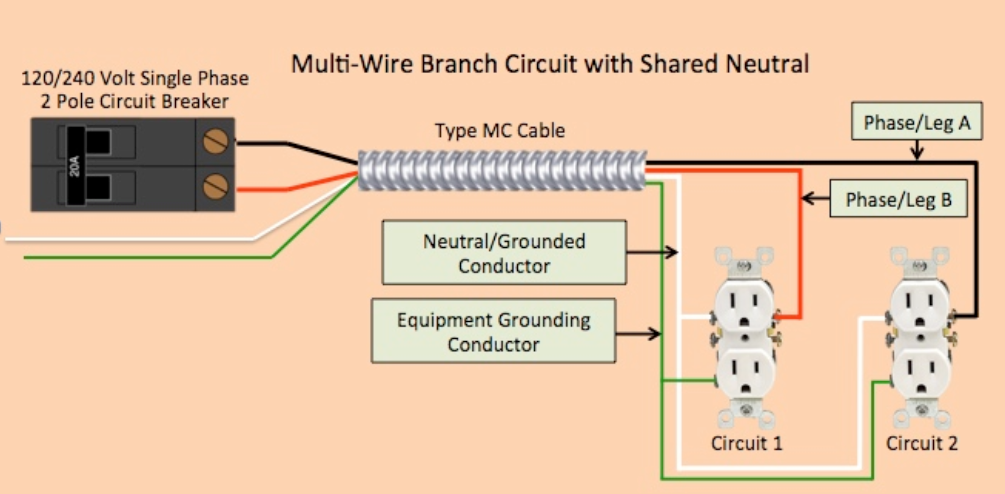
Comparing Multi-Circuit to Multi-Neutral Cables
Paul Abernathy has served the electrical industry for over 34 years as a Journeyman and Master Electrician, Author and Columnist, Licensed Electrical Inspector, Licensed Electrical Plans Examiner, Engineer II and Code Supervisor, Electrical Subject Matter Expert, and Southern Field Representative for NEMA and serves on NFPA 70 (NEC) Code Making Panel(s) #5 and #17. Currently, Paul is the Manager of Codes and Standards at Encore Wire.
advantages of mc multi-circuit & multi-neutral cables
Both Encore Wire's metal clad Multi-Circuit (MLC) and Multi-Neutral (MLN) cables are designed to provide the benefits of multiple branch circuits in a single cable assembly. The install time is decreased by up to 50% as compared to traditional MC, by eliminating the need to pull multiple cables*. Both MLC and MLN cables are offered in aluminum armor in sizes 12 AWG and 10 AWG THHN/THWN-2 solid or stranded conductors.
A Look at mc mlc construction
Encore Wire's MC MLC cable is designed to provide multiple circuit applications when two or three separate phase/leg (hot) conductors share a separate individual neutral (grounded) conductor. When sharing a neutral (grounded) conductor the installer needs to review Section 200.4(A) of the National Electrical Code [NEC], which states that you can have a single neutral (grounded) conductor share the load with other phase/leg (hot) conductors provided it is done as a multi-wire branch circuit. [See image below]

The definition of a "multi-wire branch circuit" in the NEC is "A branch circuit that consists of two or more ungrounded (hot) conductors that have voltage between them, and a grounded (neutral) conductor that has equal voltage between it and each ungrounded conductor of the circuit and that is connected to the neutral (grounded) conductor of the system."
In non-electrician terms, a standard 120/240V two-pole (two separate terminal points) circuit breaker that is inserted into a traditional electrical residential panel will provide 120V on each pole/terminal of the breaker. Since the design of the panel itself requires each single breaker location to alternate between phase/leg A and phase/leg B of a normal residential electrical service panel, the voltage from the neutral conductor to each leg will be 120V which is the "equal voltage between it and each ungrounded (hot) conductor". By using a two pole circuit breaker, commonly called a double pole breaker {or two single pole (one terminal point) circuit breakers with identified handles ties}, the device ensures each single pole circuit breaker is positioned side-by-side on opposite phases/legs in the electrical panel creating a multi-wire branch circuit. It also generates a single neutral (grounded) conductor shared by both phase/leg A and phase/leg B conductors, thus creating two distinct circuits.
MC MLN CONSTRUCTION Overview
Encore Wire's Type MC MLN cable is designed with fewer conductors than the Multi-Circuit Cable. The National Electrical Code [Section 200.4(A)] mandates that each circuit shall have its own grounded (neutral) conductor to avoid overloading a neutral by not permitting it to be shared, except when used as part of a multi-wire branch circuit. Type MC Multi-Neutral Cable has phase/leg (hot) conductors that have a corresponding white neutral (grounded) conductor that is striped in its matching phase/leg conductor color (e.g. Black, Red or Blue Stripes) to ensure proper loading of the neutral by the electrician.
key differences between mlc & mln
The main difference is that Type MC Multi-Circuit Cable contains more Phase/Leg (hot) conductors than neutral (grounded) conductors and the Type MC Multi-Neutral Cable is designed to provide the same number of neutral (grounded) conductor as phase/leg (hot) conductor.

The electrician will need to determine his/her need for either multi-wire branch circuits or the time and labor savings advantages of getting multiple branch circuits in a single cable assembly. Due to possible ampacity adjustments for those Type MC Cables that have 4 or more current carrying conductors, please be sure to review NEC section 310.15(C)(1) for more details.
.jpg) |
Paul Abernathy, CMECP |
Watch our MC MLC & MLN video for more information.
*Calculated values are based on time studies conducted. Results may vary based on job specific situations or applications.
